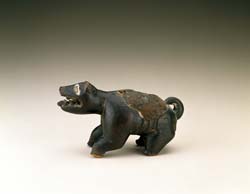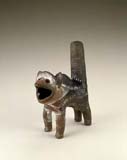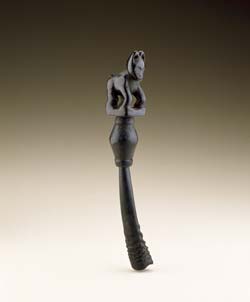
 As domestic animals, dogs in Africa are at home in the village, the land of the living. As hunting dogs, they go into the forest, the home of the dead. Objects such the dog figure and whistle (acc. nos. 98-15-8, 91-4-3), however, are associated not with a hunter of food or pelts but with a Kongo ritual specialist. These dogs symbolize the hunting of spiritual forces that would harm the village or an individual. As domestic animals, dogs in Africa are at home in the village, the land of the living. As hunting dogs, they go into the forest, the home of the dead. Objects such the dog figure and whistle (acc. nos. 98-15-8, 91-4-3), however, are associated not with a hunter of food or pelts but with a Kongo ritual specialist. These dogs symbolize the hunting of spiritual forces that would harm the village or an individual.
Some dogs are beneficial--such as the dog from oral history that led the Dogon peoples to water and safety when the Tellem peoples, who lived in the Bandiagara cliffs, hid the water sources. Others are not. Contemporary artist David Koloane recognizes the danger packs of urban feral dogs represent and compares them to the way the apartheid system made people live and the violence that grips the townships (acc. no. 96-31-1).
Hyenas are unrelated to dogs and totally untamed. Skilled hunters, they can be identified by their large ears, strong jaws, high shoulders and crest of hair. Their ambiguous even negative role in many folktales may relate to the difficulty of easily distinguishing male from female or to the animal's ability to eat all its prey, including the skin and bones.
 In the visual arts, the hyena seems less negative, appearing at the end of Bamana initiations for young men. The long jaws and big ears of the hyena mask suggest the actual animal, while the spike between the ears represents the tuft of hair from a slain animal the hunter uses in ritual medicines. The Shilluk pipe bowl (acc. no. 73-7-735) emphasizes the open jaws, mane of hair and patterned fur. In the visual arts, the hyena seems less negative, appearing at the end of Bamana initiations for young men. The long jaws and big ears of the hyena mask suggest the actual animal, while the spike between the ears represents the tuft of hair from a slain animal the hunter uses in ritual medicines. The Shilluk pipe bowl (acc. no. 73-7-735) emphasizes the open jaws, mane of hair and patterned fur.

Figure of a dog
Dogon peoples, Mali
Early to mid-20th century
Wood, encrustation
Bequest of Alexandra I. Darrow, 93-9-1
|

Whistle
Kongo peoples, Loango region, Republic of the Congo
Late 19th to early 20th century
Wood, duiker antelope horn
Museum purchase, 91-4-3
|
|
|
|